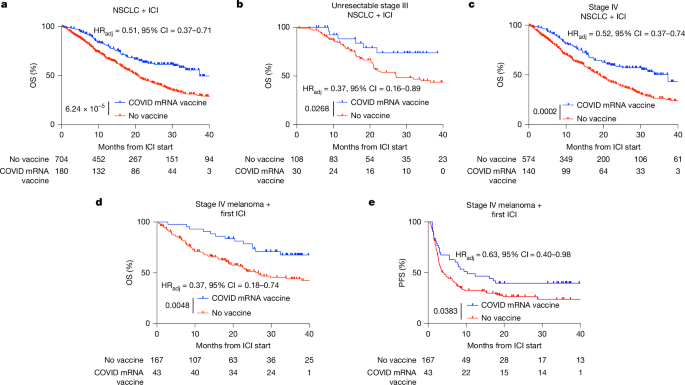Report on Enhancing Cancer Immunotherapy via mRNA Vaccines: A Contribution to Sustainable Development Goals
1.0 Introduction: Addressing Non-Communicable Diseases in Line with SDG 3
The global burden of cancer represents a significant challenge to achieving Sustainable Development Goal 3 (SDG 3), which aims to ensure good health and well-being for all. Specifically, Target 3.4 calls for a one-third reduction in premature mortality from non-communicable diseases (NCDs) by 2030. While advanced treatments like immune checkpoint inhibitors (ICIs) have improved survival for many patients, their efficacy is limited in those without pre-existing anti-cancer immunity. This report details findings that clinically available mRNA vaccines, originally developed for infectious diseases like SARS-CoV-2, can sensitize tumors to ICIs. This innovative application of existing technology offers a promising avenue to improve cancer treatment outcomes, directly contributing to the objectives of SDG 3.
2.0 Key Findings: Improving Health Outcomes and Reducing Mortality
The research provides compelling evidence from both clinical and preclinical studies, highlighting a direct impact on cancer survival rates and aligning with global health objectives.
- Improved Overall Survival: Large retrospective cohorts of patients with non-small cell lung cancer (NSCLC) and melanoma demonstrated significantly improved median and three-year overall survival when a SARS-CoV-2 mRNA vaccine was administered within 100 days of initiating ICI therapy.
- Efficacy in Resistant Tumors: The survival benefit was observed even in patients with immunologically “cold” tumors (baseline PD-L1 TPS <1%), which are typically resistant to immunotherapy. This finding suggests a method to restore immune sensitivity and broaden the patient population that can benefit from ICIs.
- Contribution to SDG 3.4: By enhancing the effectiveness of a primary cancer treatment modality, this approach directly supports the goal of reducing premature mortality from NCDs like cancer.
3.0 Mechanism of Action: A Systemic Immune Response
Preclinical models elucidated the biological mechanism by which non-tumor-related mRNA vaccines enhance anti-cancer immunity. The process follows a distinct sequence of events:
- Induction of Type I Interferon: SARS-CoV-2 mRNA vaccines trigger a substantial systemic surge in type I interferon (IFN), a key cytokine in antiviral and anti-tumor responses.
- Innate Immune Activation: The IFN surge leads to the activation of innate immune cells, particularly antigen-presenting cells (APCs), which are crucial for initiating an adaptive immune response.
- Priming of T Cells: Activated APCs prime CD8+ T cells to recognize and target tumor-associated antigens, effectively initiating a new or enhanced immune attack against the cancer.
- Sensitization to ICI Therapy: In response to the T cell infiltration, tumor cells upregulate the PD-L1 protein as a defense mechanism. This adaptive resistance makes the tumor highly susceptible to ICIs, which block the PD-1/PD-L1 pathway and sustain the anti-tumor immune assault.
4.0 Implications for Innovation, Equity, and Accessibility (SDGs 9 & 10)
The findings present a significant advancement in leveraging existing technologies to address complex health challenges, with profound implications for health equity and innovation.
- Innovation and Repurposing (SDG 9): This study exemplifies scientific innovation by repurposing a globally accessible vaccine technology to overcome a major hurdle in oncology. It demonstrates how infrastructure built for pandemic preparedness can be leveraged to fight other major diseases.
- Reducing Health Inequalities (SDG 10): Personalized cancer vaccines are resource-intensive, time-consuming, and expensive, limiting their availability primarily to high-income countries. The use of an “off-the-shelf,” low-cost, and widely available mRNA vaccine as an immune modulator could drastically reduce this accessibility gap, making advanced cancer treatment potentiation feasible in diverse economic settings.
- Universal Health Coverage (SDG 3.8): By providing a cost-effective means to enhance expensive immunotherapies, this strategy contributes to the goal of achieving universal health coverage. It offers a way to maximize the value of existing treatments and expand access to quality and effective cancer care.
5.0 Conclusion: A Sustainable Strategy for Global Cancer Care
This report concludes that clinically available mRNA vaccines function as potent immune modulators capable of sensitizing tumors to ICI therapy. This discovery provides a practical, scalable, and immediate strategy to improve outcomes for a broad range of cancer patients. By aligning with the core principles of SDG 3 (Good Health and Well-being), SDG 9 (Industry, Innovation, and Infrastructure), and SDG 10 (Reduced Inequalities), this approach represents a sustainable and equitable advancement in the global fight against cancer. It establishes a new paradigm where universal RNA therapeutics targeting infectious disease antigens can be deployed as powerful modulators of anti-tumor immunity worldwide.
SDGs, Targets, and Indicators Analysis
1. Which SDGs are addressed or connected to the issues highlighted in the article?
-
SDG 3: Good Health and Well-being
The article’s primary focus is on improving cancer treatment outcomes. It investigates how existing mRNA vaccines can enhance the efficacy of immunotherapy for non-communicable diseases like non-small cell lung cancer (NSCLC) and melanoma. The research aims to extend survival and improve the quality of life for cancer patients, which is central to SDG 3.
-
SDG 9: Industry, Innovation, and Infrastructure
This goal is addressed through the article’s emphasis on advanced scientific research and technological innovation. The study represents a novel application of mRNA vaccine technology, originally developed for infectious diseases (COVID-19), to the field of oncology. It discusses complex manufacturing processes, preclinical modeling, and the development of new therapeutic strategies, all of which fall under the umbrella of enhancing scientific research and upgrading technological capabilities (Target 9.5).
-
SDG 17: Partnerships for the Goals
The research presented is a collaborative effort involving multiple institutions. The “Authors and Affiliations” section lists numerous universities and cancer centers, such as The University of Texas MD Anderson Cancer Center and the University of Florida. The study is described as a “multicentre, retrospective, cohort study,” highlighting the multi-stakeholder partnership required to conduct such large-scale research, which aligns with the principles of SDG 17.
2. What specific targets under those SDGs can be identified based on the article’s content?
-
SDG 3: Good Health and Well-being
-
Target 3.4: By 2030, reduce by one third premature mortality from non-communicable diseases through prevention and treatment.
The article directly contributes to this target by exploring a novel treatment combination to combat cancer, a leading non-communicable disease. The study’s finding that “receipt of SARS-CoV-2 mRNA vaccines within 100 days of initiating ICI is associated with significantly improved median and three-year overall survival” in cancer patients is a direct effort to reduce premature mortality through improved treatment.
-
Target 3.b: Support the research and development of vaccines and medicines for communicable and non-communicable diseases.
The entire article is a testament to research and development in medicine. It not only describes the R&D of a new cancer immunotherapy approach but also discusses the potential for “off-the-shelf RNA-LNPs targeting… infectious disease antigens” to serve as “widely available, low-cost alternatives” for cancer treatment, touching upon the accessibility of medicines.
-
-
SDG 9: Industry, Innovation, and Infrastructure
-
Target 9.5: Enhance scientific research, upgrade the technological capabilities of industrial sectors in all countries… encouraging innovation.
The study is an example of cutting-edge scientific research that encourages innovation by repurposing an existing, widely available technology (mRNA vaccines) for a new, critical application (cancer therapy). The detailed methods, including preclinical animal models, cytokine profiling, and advanced flow cytometry, demonstrate an upgrade in technological capabilities to solve complex health problems.
-
-
SDG 17: Partnerships for the Goals
-
Target 17.16: Enhance the Global Partnership for Sustainable Development, complemented by multi-stakeholder partnerships that mobilize and share knowledge, expertise, technology and financial resources.
The study is a clear example of a multi-stakeholder partnership. As stated in the “Acknowledgements” and “Affiliations,” it involved collaboration between multiple academic and medical institutions, sharing data, expertise, and resources to achieve a common scientific goal with significant health implications.
-
3. Are there any indicators mentioned or implied in the article that can be used to measure progress towards the identified targets?
-
Indicators for SDG Target 3.4
-
Indicator 3.4.1: Mortality rate attributed to… cancer.
The article provides direct quantitative data related to this indicator. It measures treatment success through metrics such as “median OS (20.6 months versus 37.3 months),” “3 year OS (30.8% versus 55.7%),” “progression-free survival (PFS),” and “adjusted hazard ratio (HRadj).” These metrics are used to assess the reduction in mortality from cancer as a result of the proposed therapy.
-
-
Indicators for SDG Target 9.5
-
Indicator 9.5.1: Research and development expenditure as a proportion of GDP.
While not stating a national figure, the article implies significant R&D investment through its “Acknowledgements” section, which lists funding from major national bodies like the “National Cancer (NCI) Institute” and the “FDA,” as well as numerous private foundations. This points to substantial financial resources being allocated to this type of advanced scientific research.
-
Indicator 9.5.2: Researchers… per million inhabitants.
The article implies a high concentration of research talent. The extensive list of authors and their affiliations with leading cancer research centers and universities serves as a proxy indicator for the number of researchers actively engaged in high-impact medical R&D.
-
-
Indicators for SDG Target 17.16
-
Qualitative evidence of multi-stakeholder partnerships.
The article itself is an indicator of a successful partnership. The description of the study as a “multicentre, retrospective, cohort study” and the long list of collaborating institutions in the “Authors and Affiliations” section serve as direct evidence of a partnership that mobilizes and shares knowledge and expertise to advance health-related goals.
-
4. Create a table with three columns titled ‘SDGs, Targets and Indicators” to present the findings from analyzing the article. In this table, list the Sustainable Development Goals (SDGs), their corresponding targets, and the specific indicators identified in the article.
| SDGs | Targets | Indicators |
|---|---|---|
| SDG 3: Good Health and Well-being |
3.4: Reduce premature mortality from non-communicable diseases.
3.b: Support the research and development of vaccines and medicines. |
3.4.1: Mortality rate from cancer, measured in the article by:
Implied: Development of new, low-cost, and widely available therapeutic options (“off-the-shelf RNA-LNPs”). |
| SDG 9: Industry, Innovation, and Infrastructure | 9.5: Enhance scientific research and encourage innovation. |
9.5.1 (Implied): R&D expenditure, evidenced by funding from national institutions (NCI, FDA) and foundations.
9.5.2 (Implied): Number of researchers, evidenced by the large, multi-institutional team of authors. |
| SDG 17: Partnerships for the Goals | 17.16: Enhance multi-stakeholder partnerships that mobilize and share knowledge and expertise. | Qualitative Indicator: The existence of the “multicentre” research collaboration itself, involving numerous universities and cancer centers as detailed in the affiliations and acknowledgements. |
Source: nature.com







